Exercising Gear Installation Proposal: Acute Mental Ward, Hospital
VerifiedAdded on 2022/10/18
|12
|2968
|286
Report
AI Summary
This report presents a comprehensive proposal for the installation of exercise equipment in the acute mental ward of a hospital, focusing on improving the physical and mental wellbeing of patients aged 18 and above with severe mental illnesses. The proposal addresses the lack of physical exercise, which makes patients vulnerable to chronic conditions, and suggests the use of exercise equipment as a non-medicinal approach to mental health recovery. The report includes a detailed discussion of the problem, situation, target population, stakeholders, and desired outcomes, as well as a rationale for the proposal. It outlines the selection of change theory, consultation with stakeholders, barriers and management strategies, a change management plan with budget and timeframe, and evaluation and sustainability methods. The implementation plan involves hiring trainers, acquiring safe equipment, and organizing group fitness classes. The report emphasizes the importance of stakeholder involvement, efficient safeguarding of equipment, and securing funding through fundraising and donor relations. The proposed change aims to promote emotional stability, prevent social exclusion, and reduce the incidence of chronic diseases, ultimately leading to improved patient outcomes.
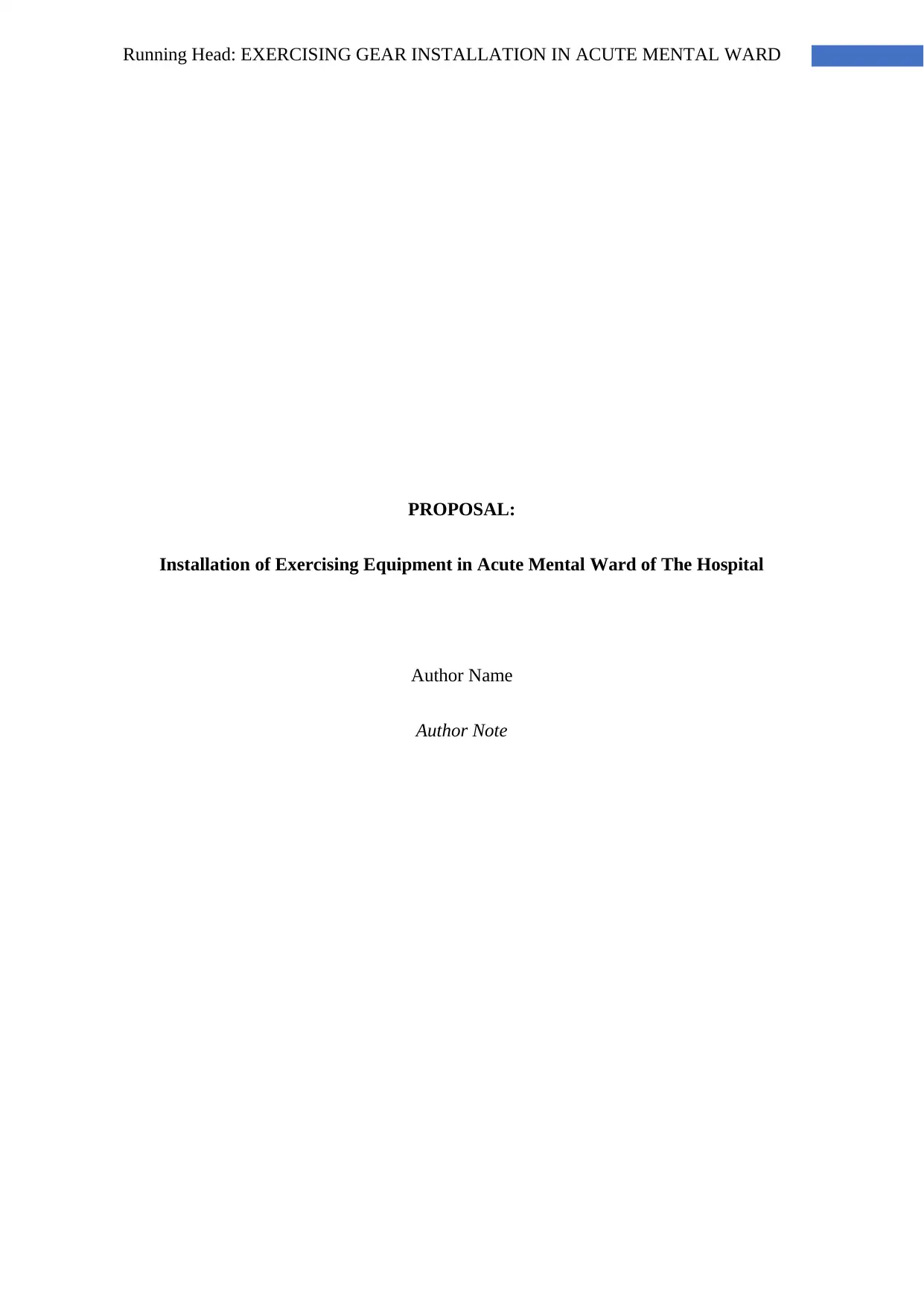
Running Head: EXERCISING GEAR INSTALLATION IN ACUTE MENTAL WARD
PROPOSAL:
Installation of Exercising Equipment in Acute Mental Ward of The Hospital
Author Name
Author Note
PROPOSAL:
Installation of Exercising Equipment in Acute Mental Ward of The Hospital
Author Name
Author Note
Paraphrase This Document
Need a fresh take? Get an instant paraphrase of this document with our AI Paraphraser
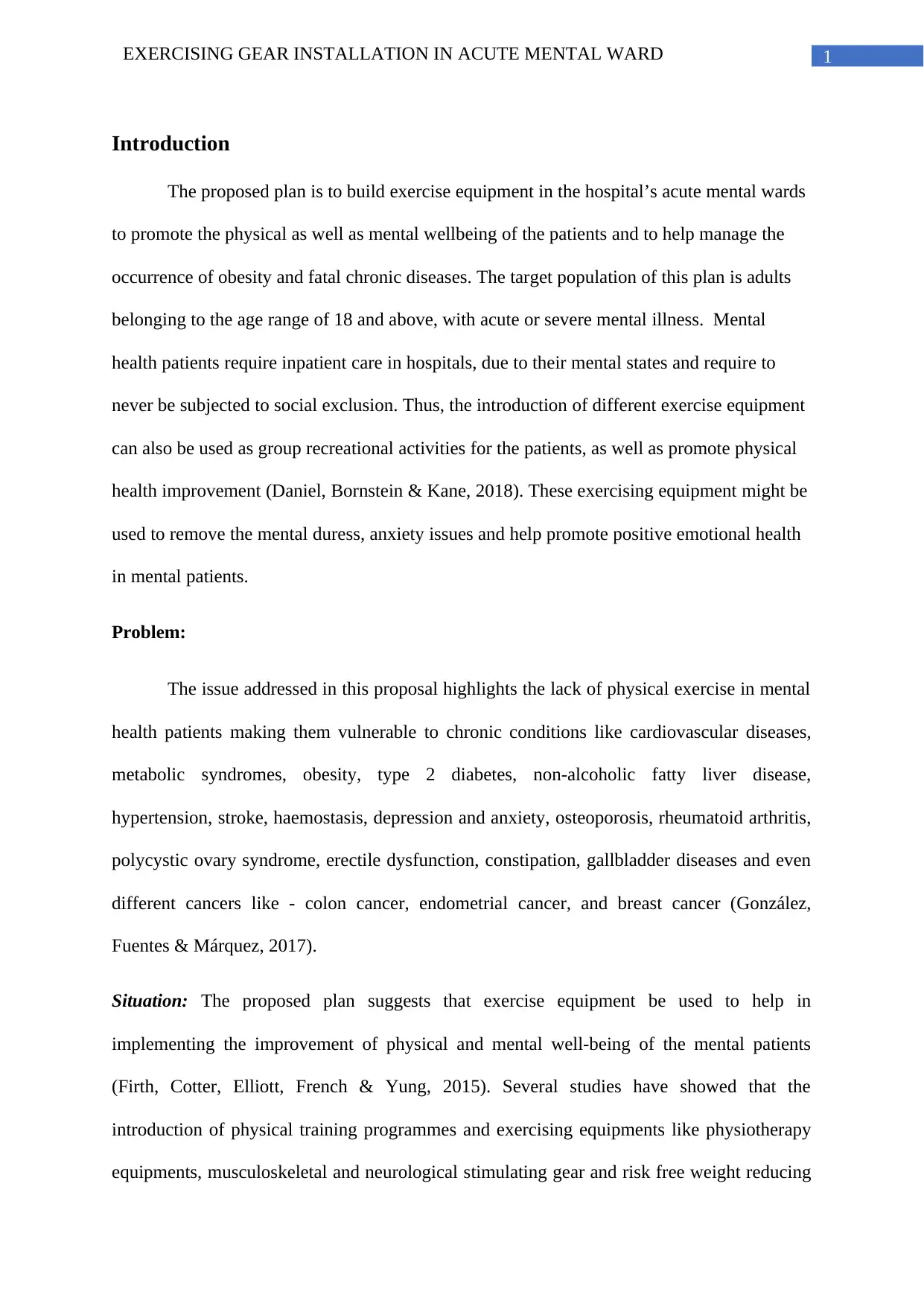
1EXERCISING GEAR INSTALLATION IN ACUTE MENTAL WARD
Introduction
The proposed plan is to build exercise equipment in the hospital’s acute mental wards
to promote the physical as well as mental wellbeing of the patients and to help manage the
occurrence of obesity and fatal chronic diseases. The target population of this plan is adults
belonging to the age range of 18 and above, with acute or severe mental illness. Mental
health patients require inpatient care in hospitals, due to their mental states and require to
never be subjected to social exclusion. Thus, the introduction of different exercise equipment
can also be used as group recreational activities for the patients, as well as promote physical
health improvement (Daniel, Bornstein & Kane, 2018). These exercising equipment might be
used to remove the mental duress, anxiety issues and help promote positive emotional health
in mental patients.
Problem:
The issue addressed in this proposal highlights the lack of physical exercise in mental
health patients making them vulnerable to chronic conditions like cardiovascular diseases,
metabolic syndromes, obesity, type 2 diabetes, non-alcoholic fatty liver disease,
hypertension, stroke, haemostasis, depression and anxiety, osteoporosis, rheumatoid arthritis,
polycystic ovary syndrome, erectile dysfunction, constipation, gallbladder diseases and even
different cancers like - colon cancer, endometrial cancer, and breast cancer (González,
Fuentes & Márquez, 2017).
Situation: The proposed plan suggests that exercise equipment be used to help in
implementing the improvement of physical and mental well-being of the mental patients
(Firth, Cotter, Elliott, French & Yung, 2015). Several studies have showed that the
introduction of physical training programmes and exercising equipments like physiotherapy
equipments, musculoskeletal and neurological stimulating gear and risk free weight reducing
Introduction
The proposed plan is to build exercise equipment in the hospital’s acute mental wards
to promote the physical as well as mental wellbeing of the patients and to help manage the
occurrence of obesity and fatal chronic diseases. The target population of this plan is adults
belonging to the age range of 18 and above, with acute or severe mental illness. Mental
health patients require inpatient care in hospitals, due to their mental states and require to
never be subjected to social exclusion. Thus, the introduction of different exercise equipment
can also be used as group recreational activities for the patients, as well as promote physical
health improvement (Daniel, Bornstein & Kane, 2018). These exercising equipment might be
used to remove the mental duress, anxiety issues and help promote positive emotional health
in mental patients.
Problem:
The issue addressed in this proposal highlights the lack of physical exercise in mental
health patients making them vulnerable to chronic conditions like cardiovascular diseases,
metabolic syndromes, obesity, type 2 diabetes, non-alcoholic fatty liver disease,
hypertension, stroke, haemostasis, depression and anxiety, osteoporosis, rheumatoid arthritis,
polycystic ovary syndrome, erectile dysfunction, constipation, gallbladder diseases and even
different cancers like - colon cancer, endometrial cancer, and breast cancer (González,
Fuentes & Márquez, 2017).
Situation: The proposed plan suggests that exercise equipment be used to help in
implementing the improvement of physical and mental well-being of the mental patients
(Firth, Cotter, Elliott, French & Yung, 2015). Several studies have showed that the
introduction of physical training programmes and exercising equipments like physiotherapy
equipments, musculoskeletal and neurological stimulating gear and risk free weight reducing
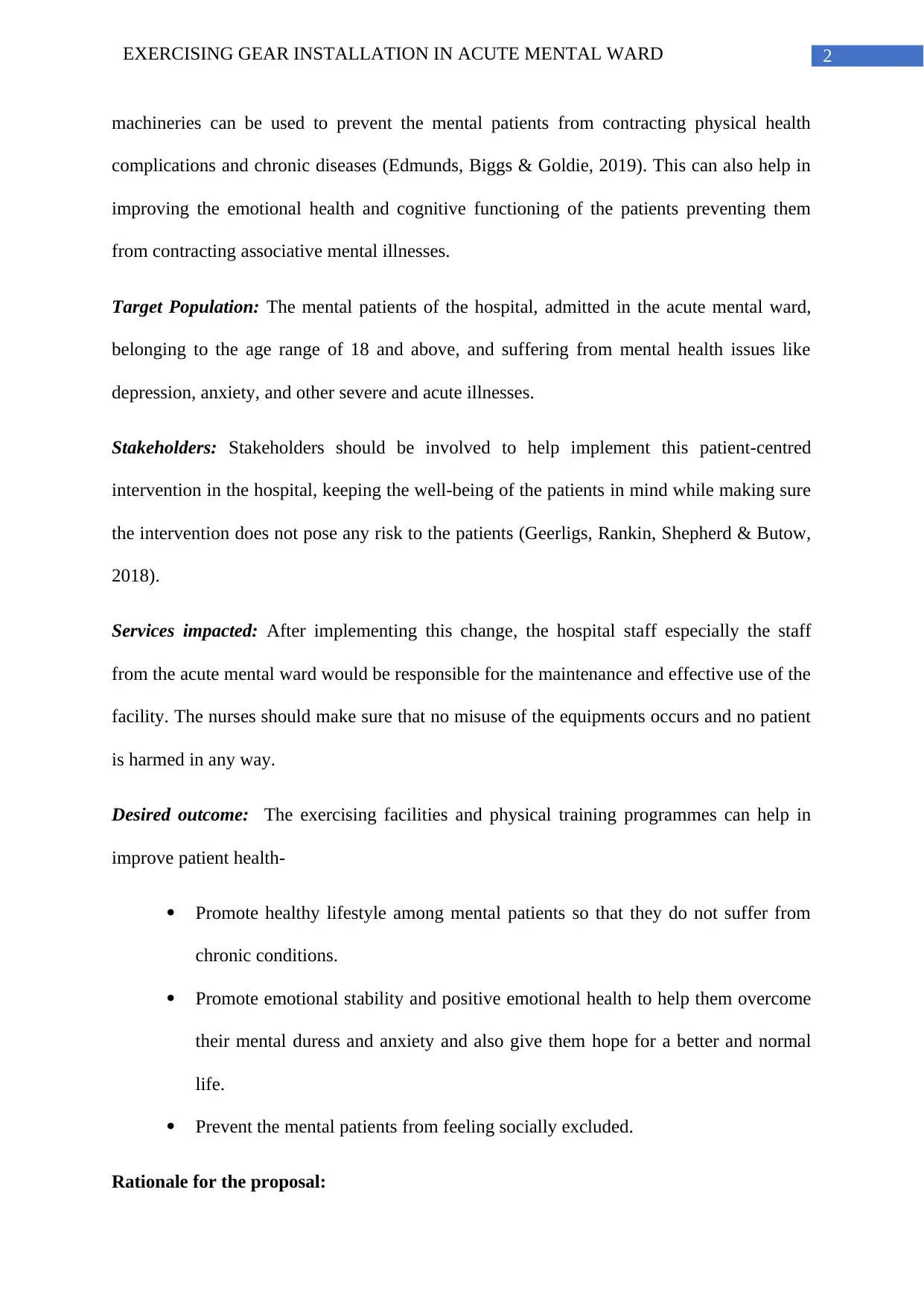
2EXERCISING GEAR INSTALLATION IN ACUTE MENTAL WARD
machineries can be used to prevent the mental patients from contracting physical health
complications and chronic diseases (Edmunds, Biggs & Goldie, 2019). This can also help in
improving the emotional health and cognitive functioning of the patients preventing them
from contracting associative mental illnesses.
Target Population: The mental patients of the hospital, admitted in the acute mental ward,
belonging to the age range of 18 and above, and suffering from mental health issues like
depression, anxiety, and other severe and acute illnesses.
Stakeholders: Stakeholders should be involved to help implement this patient-centred
intervention in the hospital, keeping the well-being of the patients in mind while making sure
the intervention does not pose any risk to the patients (Geerligs, Rankin, Shepherd & Butow,
2018).
Services impacted: After implementing this change, the hospital staff especially the staff
from the acute mental ward would be responsible for the maintenance and effective use of the
facility. The nurses should make sure that no misuse of the equipments occurs and no patient
is harmed in any way.
Desired outcome: The exercising facilities and physical training programmes can help in
improve patient health-
Promote healthy lifestyle among mental patients so that they do not suffer from
chronic conditions.
Promote emotional stability and positive emotional health to help them overcome
their mental duress and anxiety and also give them hope for a better and normal
life.
Prevent the mental patients from feeling socially excluded.
Rationale for the proposal:
machineries can be used to prevent the mental patients from contracting physical health
complications and chronic diseases (Edmunds, Biggs & Goldie, 2019). This can also help in
improving the emotional health and cognitive functioning of the patients preventing them
from contracting associative mental illnesses.
Target Population: The mental patients of the hospital, admitted in the acute mental ward,
belonging to the age range of 18 and above, and suffering from mental health issues like
depression, anxiety, and other severe and acute illnesses.
Stakeholders: Stakeholders should be involved to help implement this patient-centred
intervention in the hospital, keeping the well-being of the patients in mind while making sure
the intervention does not pose any risk to the patients (Geerligs, Rankin, Shepherd & Butow,
2018).
Services impacted: After implementing this change, the hospital staff especially the staff
from the acute mental ward would be responsible for the maintenance and effective use of the
facility. The nurses should make sure that no misuse of the equipments occurs and no patient
is harmed in any way.
Desired outcome: The exercising facilities and physical training programmes can help in
improve patient health-
Promote healthy lifestyle among mental patients so that they do not suffer from
chronic conditions.
Promote emotional stability and positive emotional health to help them overcome
their mental duress and anxiety and also give them hope for a better and normal
life.
Prevent the mental patients from feeling socially excluded.
Rationale for the proposal:
⊘ This is a preview!⊘
Do you want full access?
Subscribe today to unlock all pages.

Trusted by 1+ million students worldwide
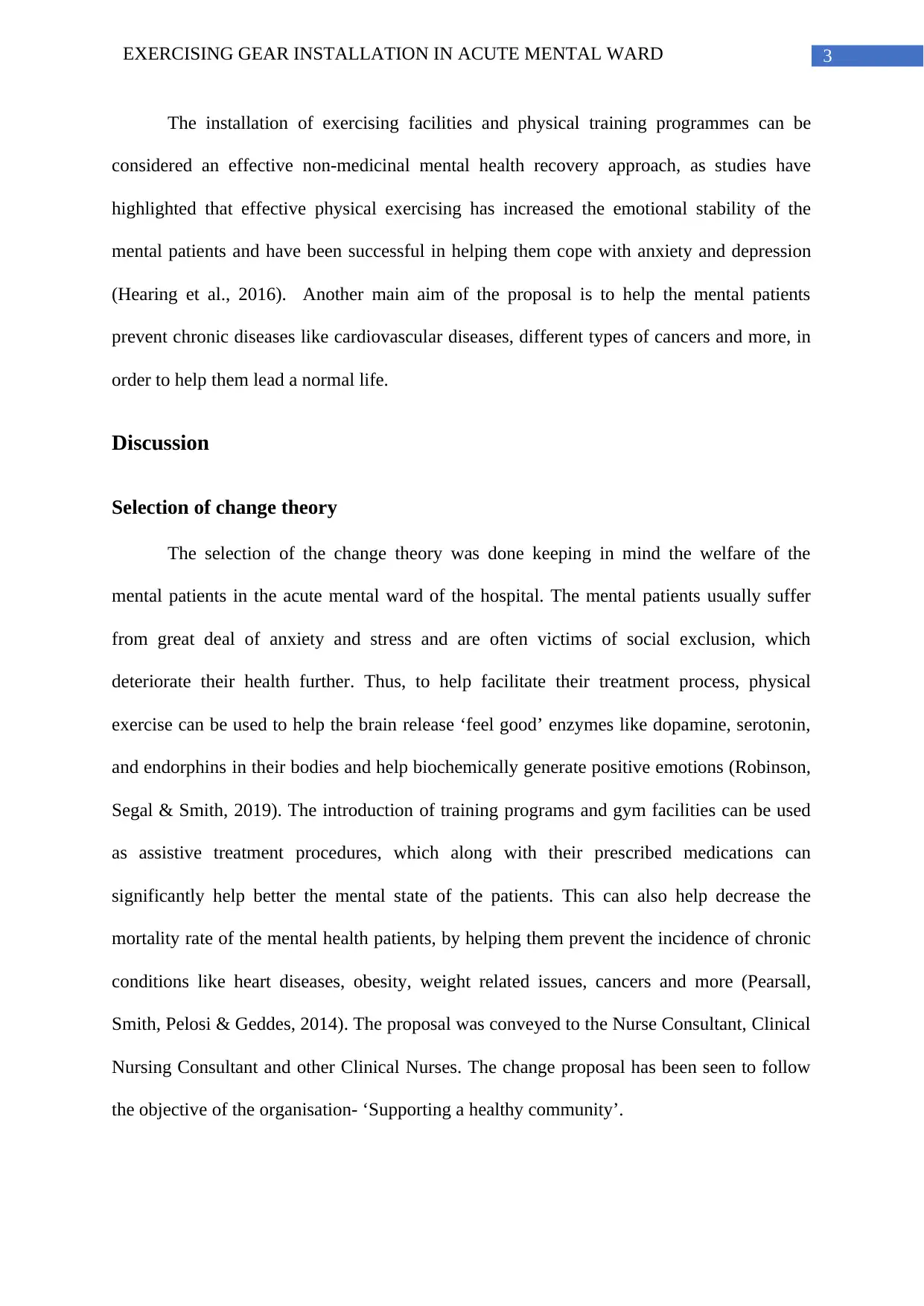
3EXERCISING GEAR INSTALLATION IN ACUTE MENTAL WARD
The installation of exercising facilities and physical training programmes can be
considered an effective non-medicinal mental health recovery approach, as studies have
highlighted that effective physical exercising has increased the emotional stability of the
mental patients and have been successful in helping them cope with anxiety and depression
(Hearing et al., 2016). Another main aim of the proposal is to help the mental patients
prevent chronic diseases like cardiovascular diseases, different types of cancers and more, in
order to help them lead a normal life.
Discussion
Selection of change theory
The selection of the change theory was done keeping in mind the welfare of the
mental patients in the acute mental ward of the hospital. The mental patients usually suffer
from great deal of anxiety and stress and are often victims of social exclusion, which
deteriorate their health further. Thus, to help facilitate their treatment process, physical
exercise can be used to help the brain release ‘feel good’ enzymes like dopamine, serotonin,
and endorphins in their bodies and help biochemically generate positive emotions (Robinson,
Segal & Smith, 2019). The introduction of training programs and gym facilities can be used
as assistive treatment procedures, which along with their prescribed medications can
significantly help better the mental state of the patients. This can also help decrease the
mortality rate of the mental health patients, by helping them prevent the incidence of chronic
conditions like heart diseases, obesity, weight related issues, cancers and more (Pearsall,
Smith, Pelosi & Geddes, 2014). The proposal was conveyed to the Nurse Consultant, Clinical
Nursing Consultant and other Clinical Nurses. The change proposal has been seen to follow
the objective of the organisation- ‘Supporting a healthy community’.
The installation of exercising facilities and physical training programmes can be
considered an effective non-medicinal mental health recovery approach, as studies have
highlighted that effective physical exercising has increased the emotional stability of the
mental patients and have been successful in helping them cope with anxiety and depression
(Hearing et al., 2016). Another main aim of the proposal is to help the mental patients
prevent chronic diseases like cardiovascular diseases, different types of cancers and more, in
order to help them lead a normal life.
Discussion
Selection of change theory
The selection of the change theory was done keeping in mind the welfare of the
mental patients in the acute mental ward of the hospital. The mental patients usually suffer
from great deal of anxiety and stress and are often victims of social exclusion, which
deteriorate their health further. Thus, to help facilitate their treatment process, physical
exercise can be used to help the brain release ‘feel good’ enzymes like dopamine, serotonin,
and endorphins in their bodies and help biochemically generate positive emotions (Robinson,
Segal & Smith, 2019). The introduction of training programs and gym facilities can be used
as assistive treatment procedures, which along with their prescribed medications can
significantly help better the mental state of the patients. This can also help decrease the
mortality rate of the mental health patients, by helping them prevent the incidence of chronic
conditions like heart diseases, obesity, weight related issues, cancers and more (Pearsall,
Smith, Pelosi & Geddes, 2014). The proposal was conveyed to the Nurse Consultant, Clinical
Nursing Consultant and other Clinical Nurses. The change proposal has been seen to follow
the objective of the organisation- ‘Supporting a healthy community’.
Paraphrase This Document
Need a fresh take? Get an instant paraphrase of this document with our AI Paraphraser
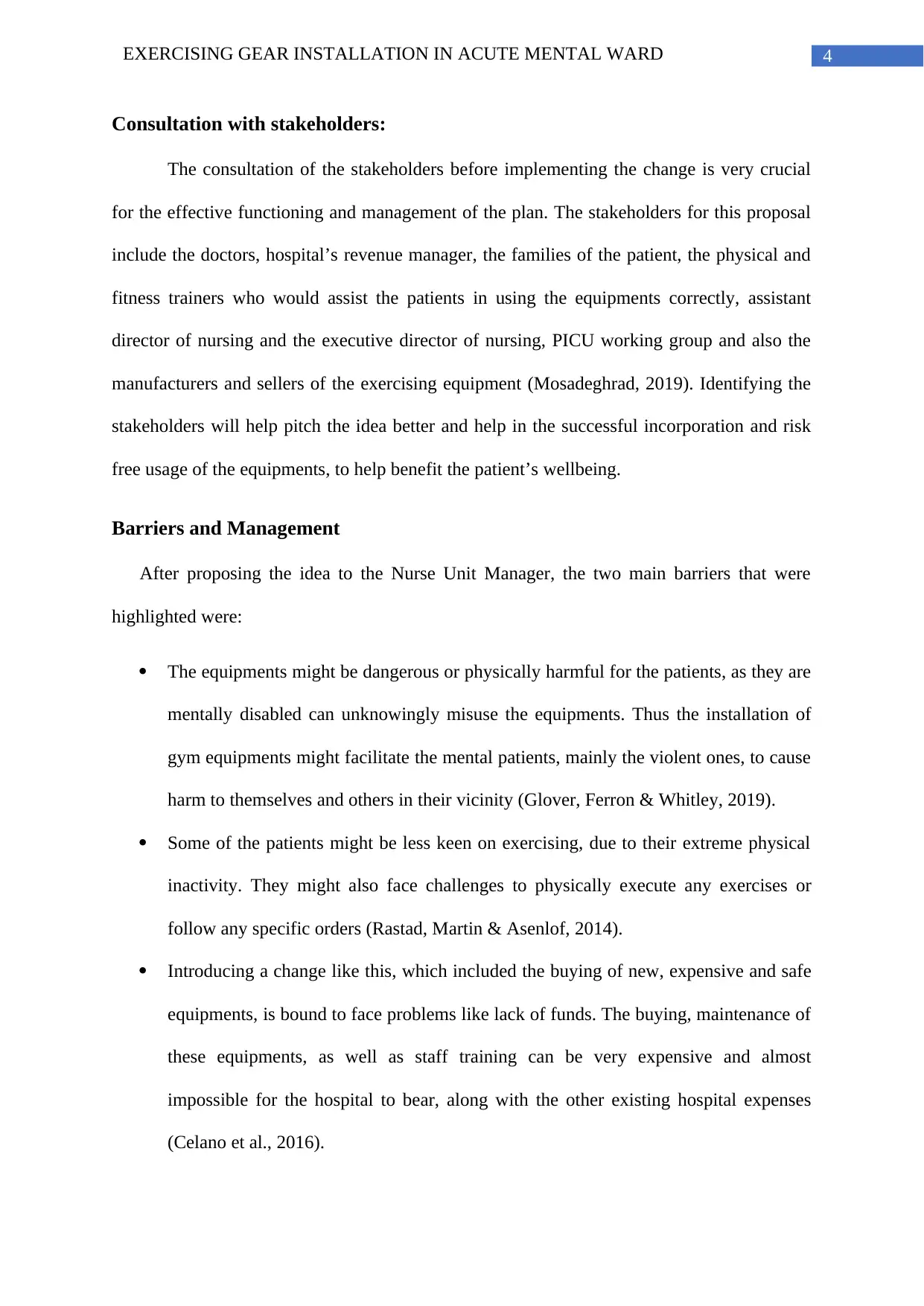
4EXERCISING GEAR INSTALLATION IN ACUTE MENTAL WARD
Consultation with stakeholders:
The consultation of the stakeholders before implementing the change is very crucial
for the effective functioning and management of the plan. The stakeholders for this proposal
include the doctors, hospital’s revenue manager, the families of the patient, the physical and
fitness trainers who would assist the patients in using the equipments correctly, assistant
director of nursing and the executive director of nursing, PICU working group and also the
manufacturers and sellers of the exercising equipment (Mosadeghrad, 2019). Identifying the
stakeholders will help pitch the idea better and help in the successful incorporation and risk
free usage of the equipments, to help benefit the patient’s wellbeing.
Barriers and Management
After proposing the idea to the Nurse Unit Manager, the two main barriers that were
highlighted were:
The equipments might be dangerous or physically harmful for the patients, as they are
mentally disabled can unknowingly misuse the equipments. Thus the installation of
gym equipments might facilitate the mental patients, mainly the violent ones, to cause
harm to themselves and others in their vicinity (Glover, Ferron & Whitley, 2019).
Some of the patients might be less keen on exercising, due to their extreme physical
inactivity. They might also face challenges to physically execute any exercises or
follow any specific orders (Rastad, Martin & Asenlof, 2014).
Introducing a change like this, which included the buying of new, expensive and safe
equipments, is bound to face problems like lack of funds. The buying, maintenance of
these equipments, as well as staff training can be very expensive and almost
impossible for the hospital to bear, along with the other existing hospital expenses
(Celano et al., 2016).
Consultation with stakeholders:
The consultation of the stakeholders before implementing the change is very crucial
for the effective functioning and management of the plan. The stakeholders for this proposal
include the doctors, hospital’s revenue manager, the families of the patient, the physical and
fitness trainers who would assist the patients in using the equipments correctly, assistant
director of nursing and the executive director of nursing, PICU working group and also the
manufacturers and sellers of the exercising equipment (Mosadeghrad, 2019). Identifying the
stakeholders will help pitch the idea better and help in the successful incorporation and risk
free usage of the equipments, to help benefit the patient’s wellbeing.
Barriers and Management
After proposing the idea to the Nurse Unit Manager, the two main barriers that were
highlighted were:
The equipments might be dangerous or physically harmful for the patients, as they are
mentally disabled can unknowingly misuse the equipments. Thus the installation of
gym equipments might facilitate the mental patients, mainly the violent ones, to cause
harm to themselves and others in their vicinity (Glover, Ferron & Whitley, 2019).
Some of the patients might be less keen on exercising, due to their extreme physical
inactivity. They might also face challenges to physically execute any exercises or
follow any specific orders (Rastad, Martin & Asenlof, 2014).
Introducing a change like this, which included the buying of new, expensive and safe
equipments, is bound to face problems like lack of funds. The buying, maintenance of
these equipments, as well as staff training can be very expensive and almost
impossible for the hospital to bear, along with the other existing hospital expenses
(Celano et al., 2016).
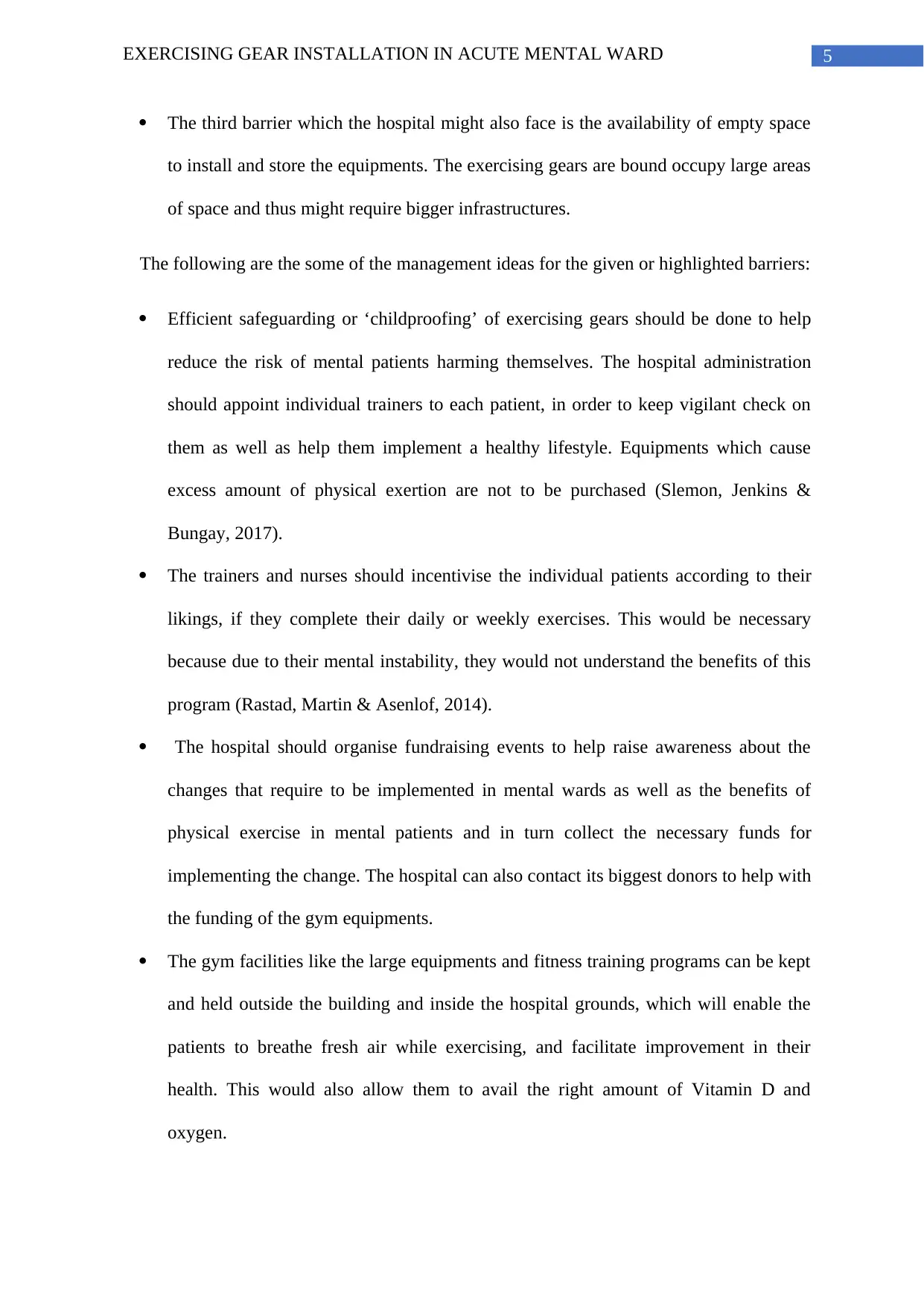
5EXERCISING GEAR INSTALLATION IN ACUTE MENTAL WARD
The third barrier which the hospital might also face is the availability of empty space
to install and store the equipments. The exercising gears are bound occupy large areas
of space and thus might require bigger infrastructures.
The following are the some of the management ideas for the given or highlighted barriers:
Efficient safeguarding or ‘childproofing’ of exercising gears should be done to help
reduce the risk of mental patients harming themselves. The hospital administration
should appoint individual trainers to each patient, in order to keep vigilant check on
them as well as help them implement a healthy lifestyle. Equipments which cause
excess amount of physical exertion are not to be purchased (Slemon, Jenkins &
Bungay, 2017).
The trainers and nurses should incentivise the individual patients according to their
likings, if they complete their daily or weekly exercises. This would be necessary
because due to their mental instability, they would not understand the benefits of this
program (Rastad, Martin & Asenlof, 2014).
The hospital should organise fundraising events to help raise awareness about the
changes that require to be implemented in mental wards as well as the benefits of
physical exercise in mental patients and in turn collect the necessary funds for
implementing the change. The hospital can also contact its biggest donors to help with
the funding of the gym equipments.
The gym facilities like the large equipments and fitness training programs can be kept
and held outside the building and inside the hospital grounds, which will enable the
patients to breathe fresh air while exercising, and facilitate improvement in their
health. This would also allow them to avail the right amount of Vitamin D and
oxygen.
The third barrier which the hospital might also face is the availability of empty space
to install and store the equipments. The exercising gears are bound occupy large areas
of space and thus might require bigger infrastructures.
The following are the some of the management ideas for the given or highlighted barriers:
Efficient safeguarding or ‘childproofing’ of exercising gears should be done to help
reduce the risk of mental patients harming themselves. The hospital administration
should appoint individual trainers to each patient, in order to keep vigilant check on
them as well as help them implement a healthy lifestyle. Equipments which cause
excess amount of physical exertion are not to be purchased (Slemon, Jenkins &
Bungay, 2017).
The trainers and nurses should incentivise the individual patients according to their
likings, if they complete their daily or weekly exercises. This would be necessary
because due to their mental instability, they would not understand the benefits of this
program (Rastad, Martin & Asenlof, 2014).
The hospital should organise fundraising events to help raise awareness about the
changes that require to be implemented in mental wards as well as the benefits of
physical exercise in mental patients and in turn collect the necessary funds for
implementing the change. The hospital can also contact its biggest donors to help with
the funding of the gym equipments.
The gym facilities like the large equipments and fitness training programs can be kept
and held outside the building and inside the hospital grounds, which will enable the
patients to breathe fresh air while exercising, and facilitate improvement in their
health. This would also allow them to avail the right amount of Vitamin D and
oxygen.
⊘ This is a preview!⊘
Do you want full access?
Subscribe today to unlock all pages.

Trusted by 1+ million students worldwide
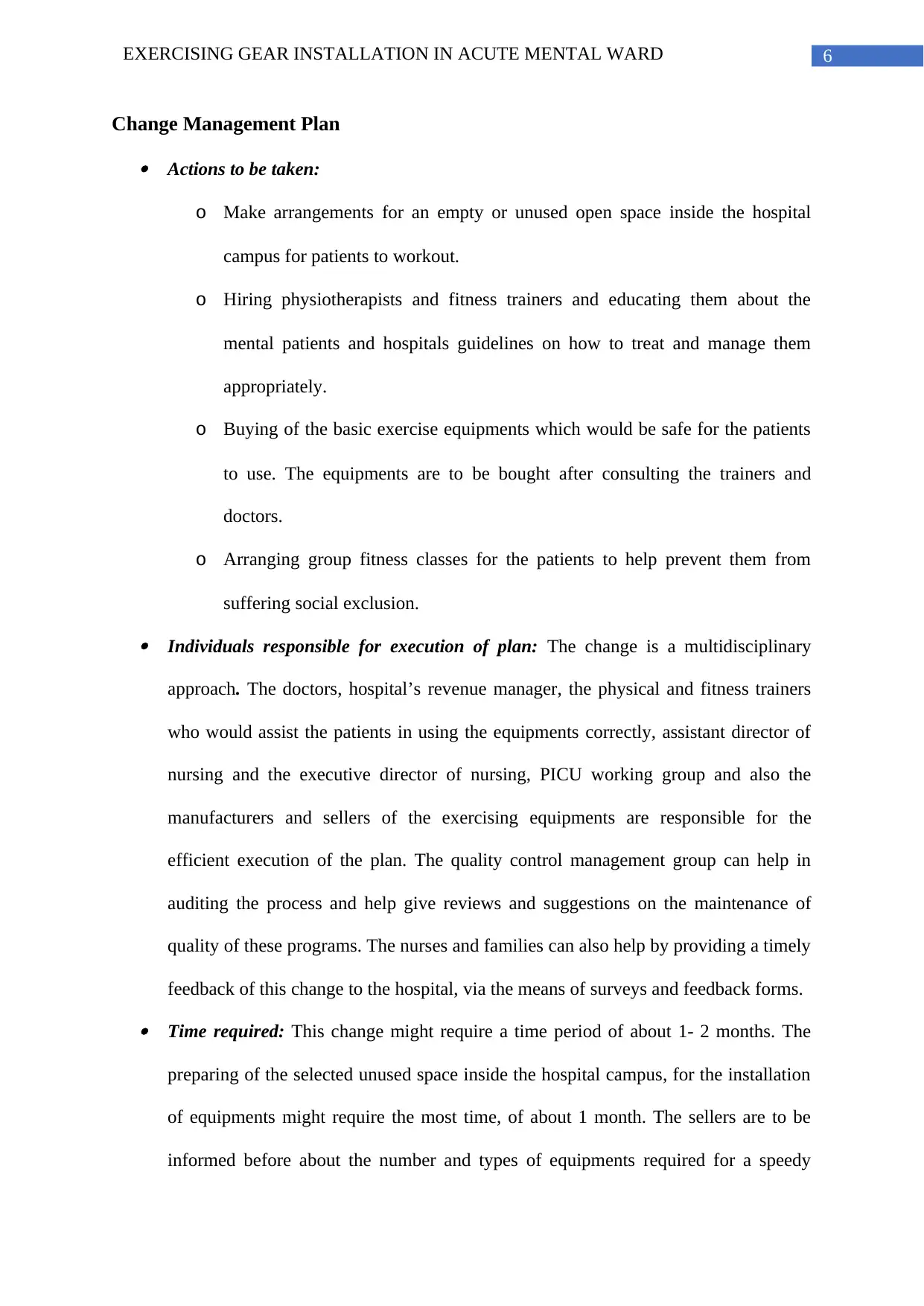
6EXERCISING GEAR INSTALLATION IN ACUTE MENTAL WARD
Change Management Plan Actions to be taken:
o Make arrangements for an empty or unused open space inside the hospital
campus for patients to workout.
o Hiring physiotherapists and fitness trainers and educating them about the
mental patients and hospitals guidelines on how to treat and manage them
appropriately.
o Buying of the basic exercise equipments which would be safe for the patients
to use. The equipments are to be bought after consulting the trainers and
doctors.
o Arranging group fitness classes for the patients to help prevent them from
suffering social exclusion. Individuals responsible for execution of plan: The change is a multidisciplinary
approach. The doctors, hospital’s revenue manager, the physical and fitness trainers
who would assist the patients in using the equipments correctly, assistant director of
nursing and the executive director of nursing, PICU working group and also the
manufacturers and sellers of the exercising equipments are responsible for the
efficient execution of the plan. The quality control management group can help in
auditing the process and help give reviews and suggestions on the maintenance of
quality of these programs. The nurses and families can also help by providing a timely
feedback of this change to the hospital, via the means of surveys and feedback forms. Time required: This change might require a time period of about 1- 2 months. The
preparing of the selected unused space inside the hospital campus, for the installation
of equipments might require the most time, of about 1 month. The sellers are to be
informed before about the number and types of equipments required for a speedy
Change Management Plan Actions to be taken:
o Make arrangements for an empty or unused open space inside the hospital
campus for patients to workout.
o Hiring physiotherapists and fitness trainers and educating them about the
mental patients and hospitals guidelines on how to treat and manage them
appropriately.
o Buying of the basic exercise equipments which would be safe for the patients
to use. The equipments are to be bought after consulting the trainers and
doctors.
o Arranging group fitness classes for the patients to help prevent them from
suffering social exclusion. Individuals responsible for execution of plan: The change is a multidisciplinary
approach. The doctors, hospital’s revenue manager, the physical and fitness trainers
who would assist the patients in using the equipments correctly, assistant director of
nursing and the executive director of nursing, PICU working group and also the
manufacturers and sellers of the exercising equipments are responsible for the
efficient execution of the plan. The quality control management group can help in
auditing the process and help give reviews and suggestions on the maintenance of
quality of these programs. The nurses and families can also help by providing a timely
feedback of this change to the hospital, via the means of surveys and feedback forms. Time required: This change might require a time period of about 1- 2 months. The
preparing of the selected unused space inside the hospital campus, for the installation
of equipments might require the most time, of about 1 month. The sellers are to be
informed before about the number and types of equipments required for a speedy
Paraphrase This Document
Need a fresh take? Get an instant paraphrase of this document with our AI Paraphraser
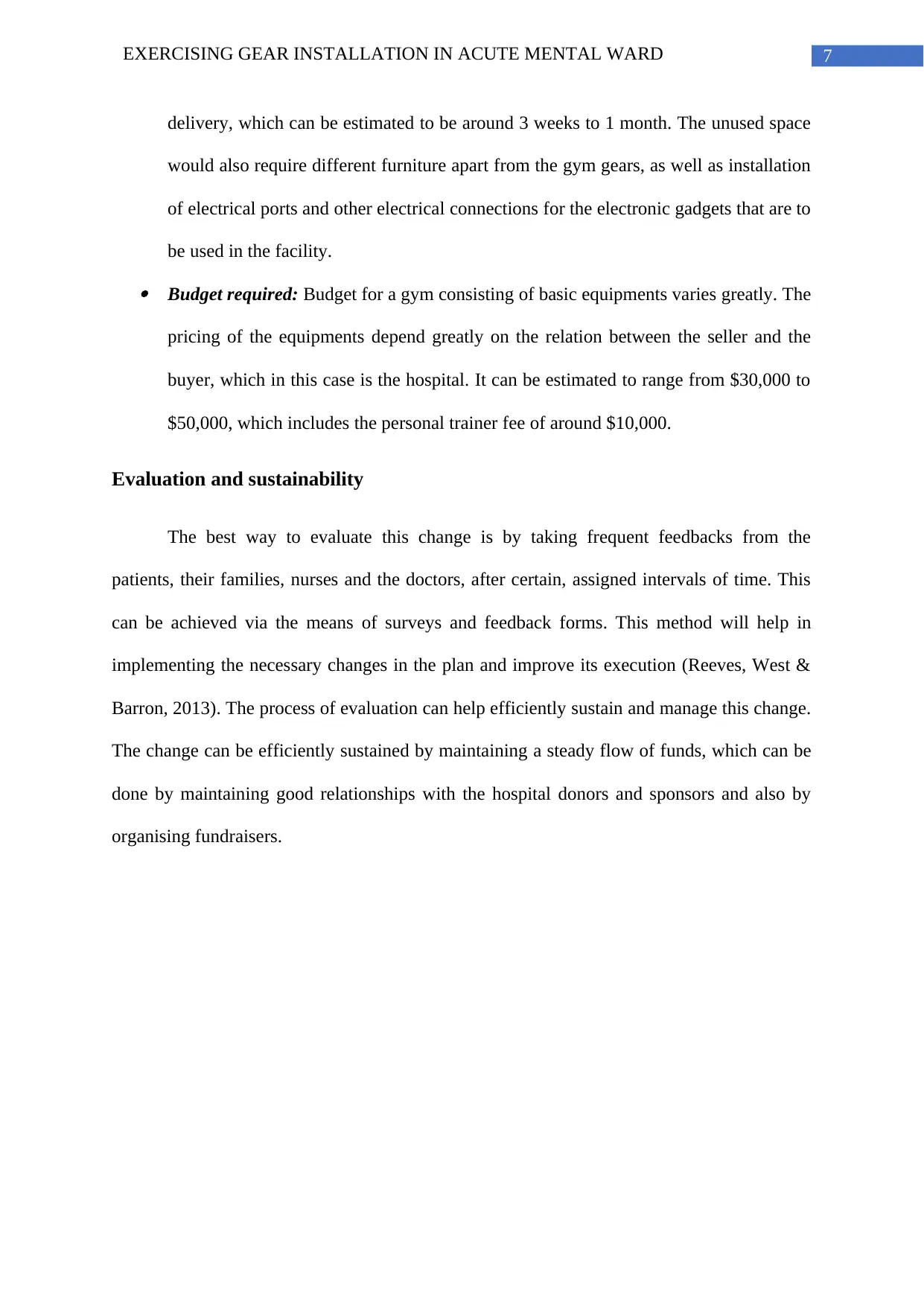
7EXERCISING GEAR INSTALLATION IN ACUTE MENTAL WARD
delivery, which can be estimated to be around 3 weeks to 1 month. The unused space
would also require different furniture apart from the gym gears, as well as installation
of electrical ports and other electrical connections for the electronic gadgets that are to
be used in the facility. Budget required: Budget for a gym consisting of basic equipments varies greatly. The
pricing of the equipments depend greatly on the relation between the seller and the
buyer, which in this case is the hospital. It can be estimated to range from $30,000 to
$50,000, which includes the personal trainer fee of around $10,000.
Evaluation and sustainability
The best way to evaluate this change is by taking frequent feedbacks from the
patients, their families, nurses and the doctors, after certain, assigned intervals of time. This
can be achieved via the means of surveys and feedback forms. This method will help in
implementing the necessary changes in the plan and improve its execution (Reeves, West &
Barron, 2013). The process of evaluation can help efficiently sustain and manage this change.
The change can be efficiently sustained by maintaining a steady flow of funds, which can be
done by maintaining good relationships with the hospital donors and sponsors and also by
organising fundraisers.
delivery, which can be estimated to be around 3 weeks to 1 month. The unused space
would also require different furniture apart from the gym gears, as well as installation
of electrical ports and other electrical connections for the electronic gadgets that are to
be used in the facility. Budget required: Budget for a gym consisting of basic equipments varies greatly. The
pricing of the equipments depend greatly on the relation between the seller and the
buyer, which in this case is the hospital. It can be estimated to range from $30,000 to
$50,000, which includes the personal trainer fee of around $10,000.
Evaluation and sustainability
The best way to evaluate this change is by taking frequent feedbacks from the
patients, their families, nurses and the doctors, after certain, assigned intervals of time. This
can be achieved via the means of surveys and feedback forms. This method will help in
implementing the necessary changes in the plan and improve its execution (Reeves, West &
Barron, 2013). The process of evaluation can help efficiently sustain and manage this change.
The change can be efficiently sustained by maintaining a steady flow of funds, which can be
done by maintaining good relationships with the hospital donors and sponsors and also by
organising fundraisers.
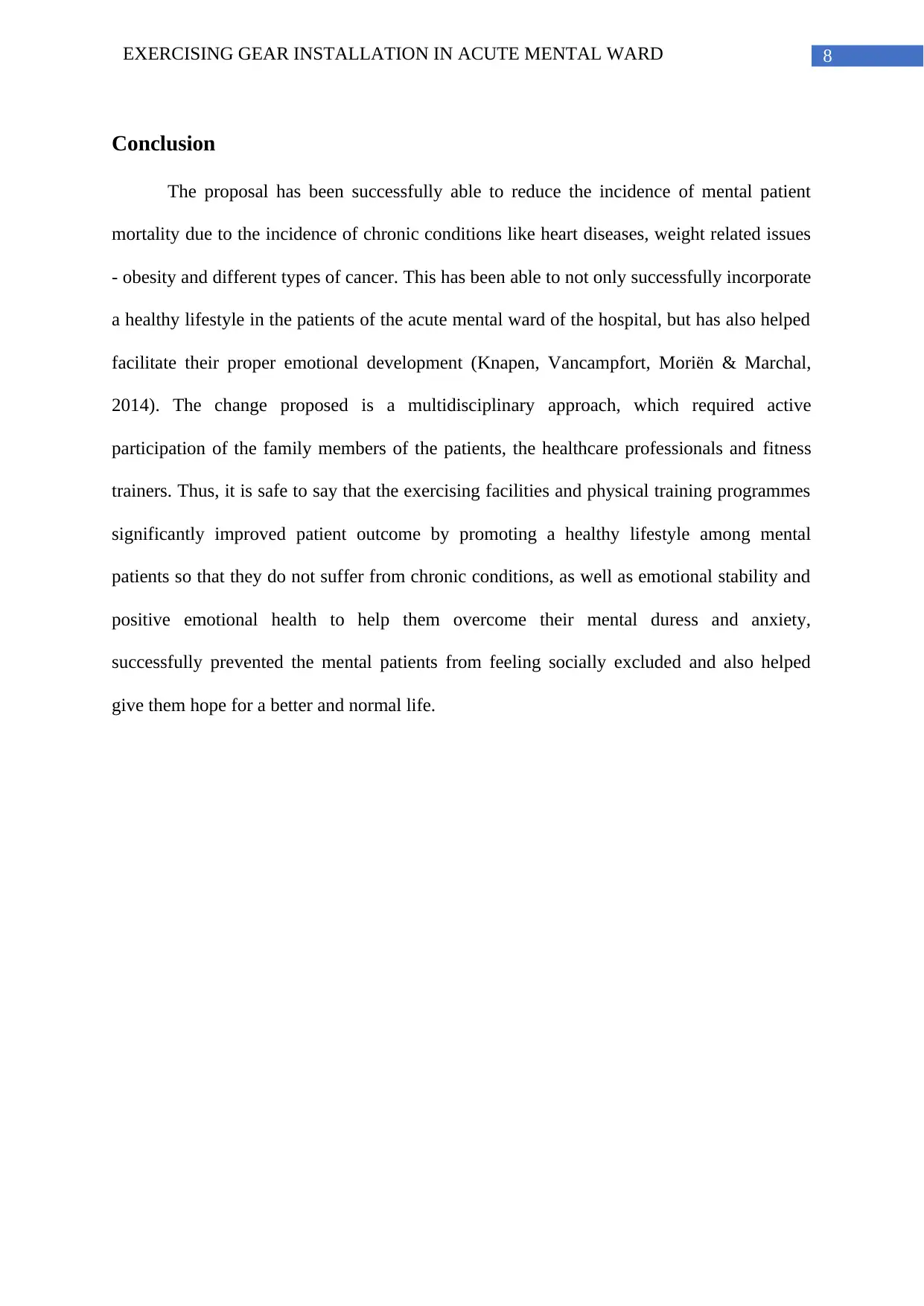
8EXERCISING GEAR INSTALLATION IN ACUTE MENTAL WARD
Conclusion
The proposal has been successfully able to reduce the incidence of mental patient
mortality due to the incidence of chronic conditions like heart diseases, weight related issues
- obesity and different types of cancer. This has been able to not only successfully incorporate
a healthy lifestyle in the patients of the acute mental ward of the hospital, but has also helped
facilitate their proper emotional development (Knapen, Vancampfort, Moriën & Marchal,
2014). The change proposed is a multidisciplinary approach, which required active
participation of the family members of the patients, the healthcare professionals and fitness
trainers. Thus, it is safe to say that the exercising facilities and physical training programmes
significantly improved patient outcome by promoting a healthy lifestyle among mental
patients so that they do not suffer from chronic conditions, as well as emotional stability and
positive emotional health to help them overcome their mental duress and anxiety,
successfully prevented the mental patients from feeling socially excluded and also helped
give them hope for a better and normal life.
Conclusion
The proposal has been successfully able to reduce the incidence of mental patient
mortality due to the incidence of chronic conditions like heart diseases, weight related issues
- obesity and different types of cancer. This has been able to not only successfully incorporate
a healthy lifestyle in the patients of the acute mental ward of the hospital, but has also helped
facilitate their proper emotional development (Knapen, Vancampfort, Moriën & Marchal,
2014). The change proposed is a multidisciplinary approach, which required active
participation of the family members of the patients, the healthcare professionals and fitness
trainers. Thus, it is safe to say that the exercising facilities and physical training programmes
significantly improved patient outcome by promoting a healthy lifestyle among mental
patients so that they do not suffer from chronic conditions, as well as emotional stability and
positive emotional health to help them overcome their mental duress and anxiety,
successfully prevented the mental patients from feeling socially excluded and also helped
give them hope for a better and normal life.
⊘ This is a preview!⊘
Do you want full access?
Subscribe today to unlock all pages.

Trusted by 1+ million students worldwide
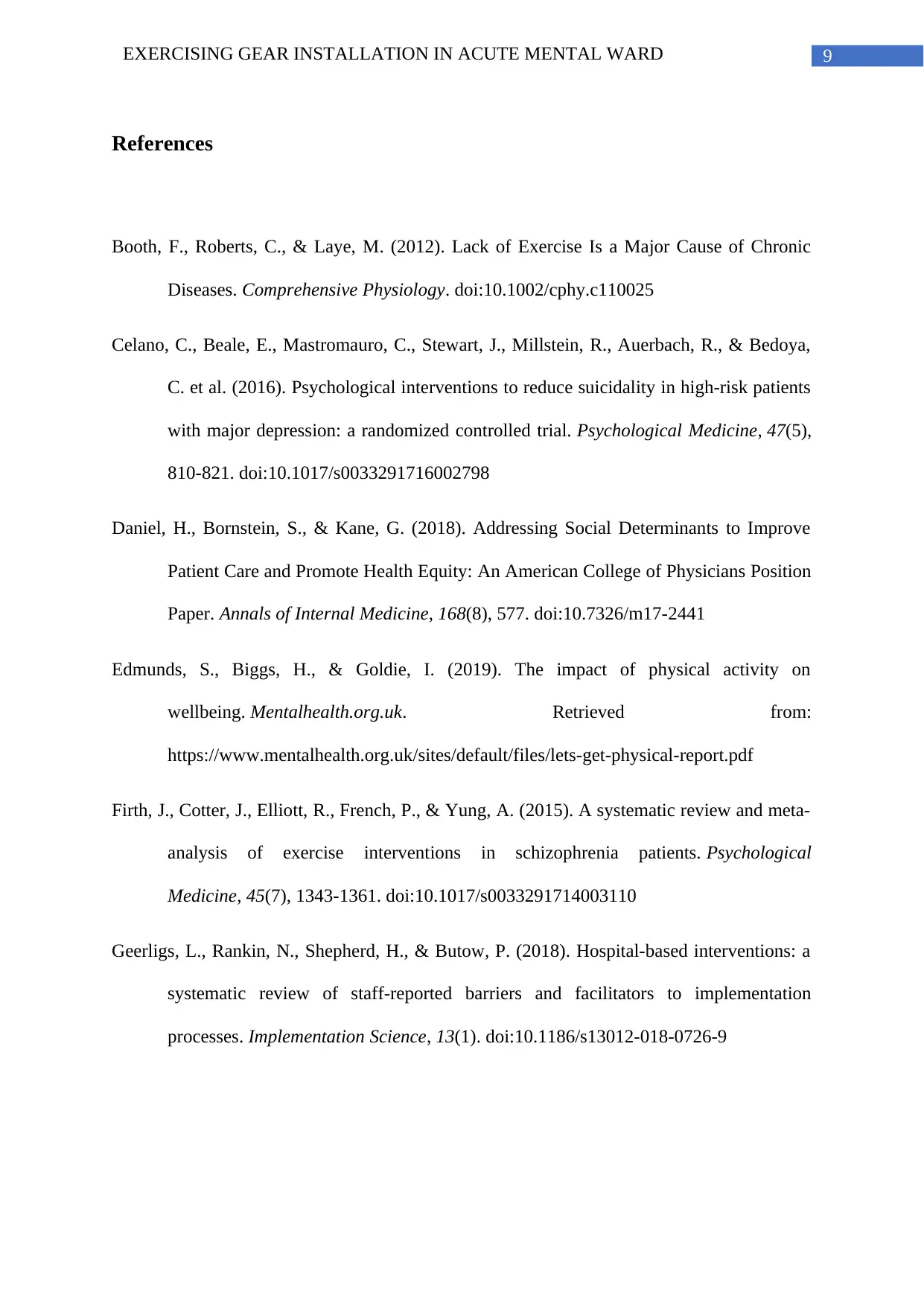
9EXERCISING GEAR INSTALLATION IN ACUTE MENTAL WARD
References
Booth, F., Roberts, C., & Laye, M. (2012). Lack of Exercise Is a Major Cause of Chronic
Diseases. Comprehensive Physiology. doi:10.1002/cphy.c110025
Celano, C., Beale, E., Mastromauro, C., Stewart, J., Millstein, R., Auerbach, R., & Bedoya,
C. et al. (2016). Psychological interventions to reduce suicidality in high-risk patients
with major depression: a randomized controlled trial. Psychological Medicine, 47(5),
810-821. doi:10.1017/s0033291716002798
Daniel, H., Bornstein, S., & Kane, G. (2018). Addressing Social Determinants to Improve
Patient Care and Promote Health Equity: An American College of Physicians Position
Paper. Annals of Internal Medicine, 168(8), 577. doi:10.7326/m17-2441
Edmunds, S., Biggs, H., & Goldie, I. (2019). The impact of physical activity on
wellbeing. Mentalhealth.org.uk. Retrieved from:
https://www.mentalhealth.org.uk/sites/default/files/lets-get-physical-report.pdf
Firth, J., Cotter, J., Elliott, R., French, P., & Yung, A. (2015). A systematic review and meta-
analysis of exercise interventions in schizophrenia patients. Psychological
Medicine, 45(7), 1343-1361. doi:10.1017/s0033291714003110
Geerligs, L., Rankin, N., Shepherd, H., & Butow, P. (2018). Hospital-based interventions: a
systematic review of staff-reported barriers and facilitators to implementation
processes. Implementation Science, 13(1). doi:10.1186/s13012-018-0726-9
References
Booth, F., Roberts, C., & Laye, M. (2012). Lack of Exercise Is a Major Cause of Chronic
Diseases. Comprehensive Physiology. doi:10.1002/cphy.c110025
Celano, C., Beale, E., Mastromauro, C., Stewart, J., Millstein, R., Auerbach, R., & Bedoya,
C. et al. (2016). Psychological interventions to reduce suicidality in high-risk patients
with major depression: a randomized controlled trial. Psychological Medicine, 47(5),
810-821. doi:10.1017/s0033291716002798
Daniel, H., Bornstein, S., & Kane, G. (2018). Addressing Social Determinants to Improve
Patient Care and Promote Health Equity: An American College of Physicians Position
Paper. Annals of Internal Medicine, 168(8), 577. doi:10.7326/m17-2441
Edmunds, S., Biggs, H., & Goldie, I. (2019). The impact of physical activity on
wellbeing. Mentalhealth.org.uk. Retrieved from:
https://www.mentalhealth.org.uk/sites/default/files/lets-get-physical-report.pdf
Firth, J., Cotter, J., Elliott, R., French, P., & Yung, A. (2015). A systematic review and meta-
analysis of exercise interventions in schizophrenia patients. Psychological
Medicine, 45(7), 1343-1361. doi:10.1017/s0033291714003110
Geerligs, L., Rankin, N., Shepherd, H., & Butow, P. (2018). Hospital-based interventions: a
systematic review of staff-reported barriers and facilitators to implementation
processes. Implementation Science, 13(1). doi:10.1186/s13012-018-0726-9
Paraphrase This Document
Need a fresh take? Get an instant paraphrase of this document with our AI Paraphraser
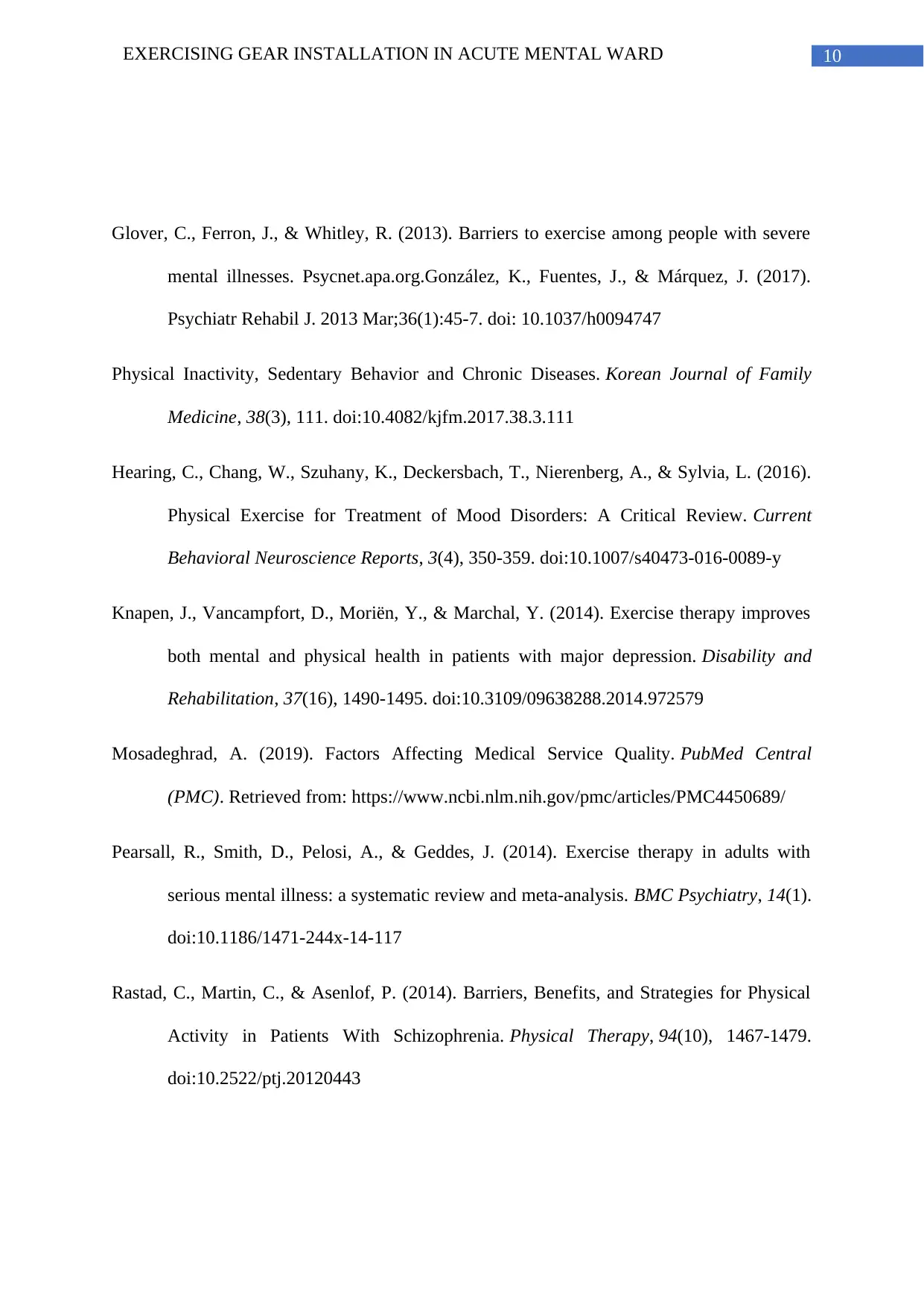
10EXERCISING GEAR INSTALLATION IN ACUTE MENTAL WARD
Glover, C., Ferron, J., & Whitley, R. (2013). Barriers to exercise among people with severe
mental illnesses. Psycnet.apa.org.González, K., Fuentes, J., & Márquez, J. (2017).
Psychiatr Rehabil J. 2013 Mar;36(1):45-7. doi: 10.1037/h0094747
Physical Inactivity, Sedentary Behavior and Chronic Diseases. Korean Journal of Family
Medicine, 38(3), 111. doi:10.4082/kjfm.2017.38.3.111
Hearing, C., Chang, W., Szuhany, K., Deckersbach, T., Nierenberg, A., & Sylvia, L. (2016).
Physical Exercise for Treatment of Mood Disorders: A Critical Review. Current
Behavioral Neuroscience Reports, 3(4), 350-359. doi:10.1007/s40473-016-0089-y
Knapen, J., Vancampfort, D., Moriën, Y., & Marchal, Y. (2014). Exercise therapy improves
both mental and physical health in patients with major depression. Disability and
Rehabilitation, 37(16), 1490-1495. doi:10.3109/09638288.2014.972579
Mosadeghrad, A. (2019). Factors Affecting Medical Service Quality. PubMed Central
(PMC). Retrieved from: https://www.ncbi.nlm.nih.gov/pmc/articles/PMC4450689/
Pearsall, R., Smith, D., Pelosi, A., & Geddes, J. (2014). Exercise therapy in adults with
serious mental illness: a systematic review and meta-analysis. BMC Psychiatry, 14(1).
doi:10.1186/1471-244x-14-117
Rastad, C., Martin, C., & Asenlof, P. (2014). Barriers, Benefits, and Strategies for Physical
Activity in Patients With Schizophrenia. Physical Therapy, 94(10), 1467-1479.
doi:10.2522/ptj.20120443
Glover, C., Ferron, J., & Whitley, R. (2013). Barriers to exercise among people with severe
mental illnesses. Psycnet.apa.org.González, K., Fuentes, J., & Márquez, J. (2017).
Psychiatr Rehabil J. 2013 Mar;36(1):45-7. doi: 10.1037/h0094747
Physical Inactivity, Sedentary Behavior and Chronic Diseases. Korean Journal of Family
Medicine, 38(3), 111. doi:10.4082/kjfm.2017.38.3.111
Hearing, C., Chang, W., Szuhany, K., Deckersbach, T., Nierenberg, A., & Sylvia, L. (2016).
Physical Exercise for Treatment of Mood Disorders: A Critical Review. Current
Behavioral Neuroscience Reports, 3(4), 350-359. doi:10.1007/s40473-016-0089-y
Knapen, J., Vancampfort, D., Moriën, Y., & Marchal, Y. (2014). Exercise therapy improves
both mental and physical health in patients with major depression. Disability and
Rehabilitation, 37(16), 1490-1495. doi:10.3109/09638288.2014.972579
Mosadeghrad, A. (2019). Factors Affecting Medical Service Quality. PubMed Central
(PMC). Retrieved from: https://www.ncbi.nlm.nih.gov/pmc/articles/PMC4450689/
Pearsall, R., Smith, D., Pelosi, A., & Geddes, J. (2014). Exercise therapy in adults with
serious mental illness: a systematic review and meta-analysis. BMC Psychiatry, 14(1).
doi:10.1186/1471-244x-14-117
Rastad, C., Martin, C., & Asenlof, P. (2014). Barriers, Benefits, and Strategies for Physical
Activity in Patients With Schizophrenia. Physical Therapy, 94(10), 1467-1479.
doi:10.2522/ptj.20120443
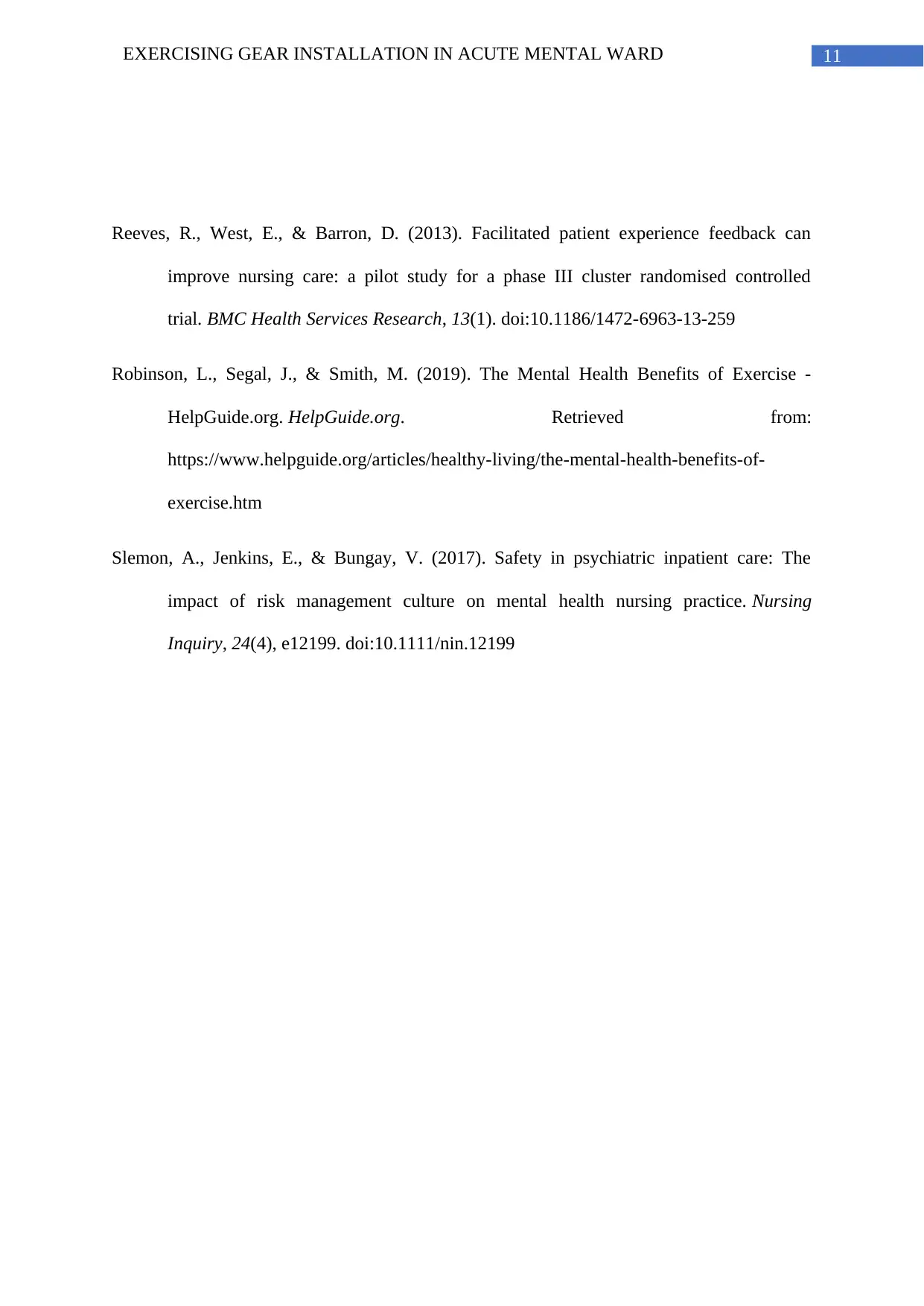
11EXERCISING GEAR INSTALLATION IN ACUTE MENTAL WARD
Reeves, R., West, E., & Barron, D. (2013). Facilitated patient experience feedback can
improve nursing care: a pilot study for a phase III cluster randomised controlled
trial. BMC Health Services Research, 13(1). doi:10.1186/1472-6963-13-259
Robinson, L., Segal, J., & Smith, M. (2019). The Mental Health Benefits of Exercise -
HelpGuide.org. HelpGuide.org. Retrieved from:
https://www.helpguide.org/articles/healthy-living/the-mental-health-benefits-of-
exercise.htm
Slemon, A., Jenkins, E., & Bungay, V. (2017). Safety in psychiatric inpatient care: The
impact of risk management culture on mental health nursing practice. Nursing
Inquiry, 24(4), e12199. doi:10.1111/nin.12199
Reeves, R., West, E., & Barron, D. (2013). Facilitated patient experience feedback can
improve nursing care: a pilot study for a phase III cluster randomised controlled
trial. BMC Health Services Research, 13(1). doi:10.1186/1472-6963-13-259
Robinson, L., Segal, J., & Smith, M. (2019). The Mental Health Benefits of Exercise -
HelpGuide.org. HelpGuide.org. Retrieved from:
https://www.helpguide.org/articles/healthy-living/the-mental-health-benefits-of-
exercise.htm
Slemon, A., Jenkins, E., & Bungay, V. (2017). Safety in psychiatric inpatient care: The
impact of risk management culture on mental health nursing practice. Nursing
Inquiry, 24(4), e12199. doi:10.1111/nin.12199
⊘ This is a preview!⊘
Do you want full access?
Subscribe today to unlock all pages.

Trusted by 1+ million students worldwide
1 out of 12
Related Documents
Your All-in-One AI-Powered Toolkit for Academic Success.
+13062052269
info@desklib.com
Available 24*7 on WhatsApp / Email
![[object Object]](/_next/static/media/star-bottom.7253800d.svg)
Unlock your academic potential
Copyright © 2020–2025 A2Z Services. All Rights Reserved. Developed and managed by ZUCOL.





